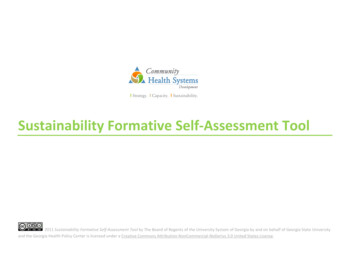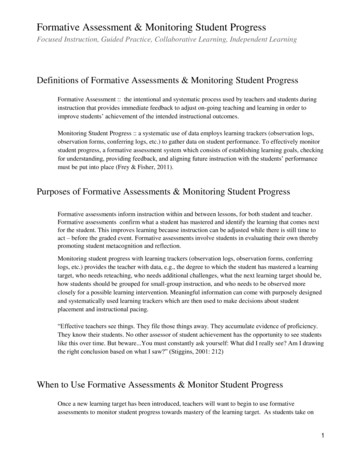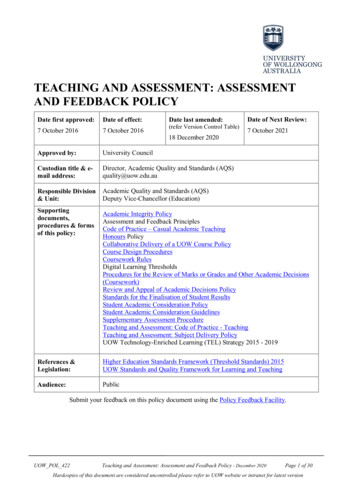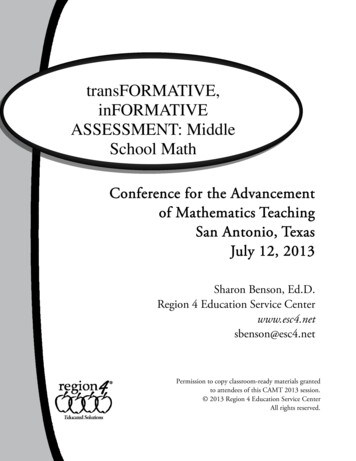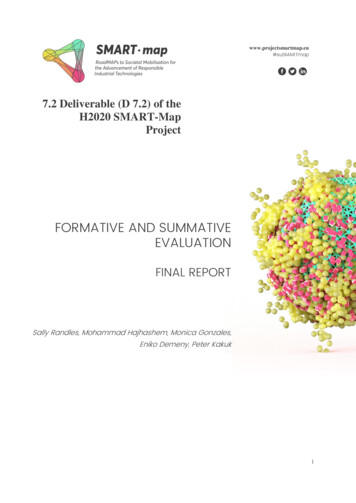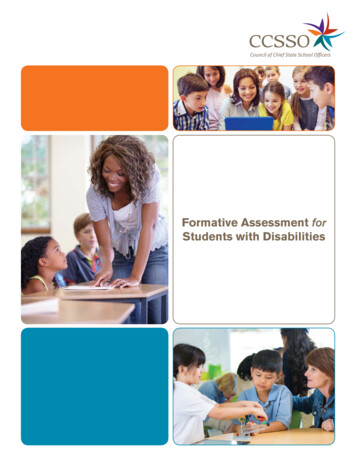
Transcription
Formative Assessment forStudents with Disabilities
THE COUNCIL OF CHIEF STATE SCHOOL OFFICERSThe Council of Chief State School Officers (CCSSO) is a nonpartisan, nationwide, nonprofit organization of public officialswho head departments of elementary and secondary education in the states, the District of Columbia, the Departmentof Defense Education Activity, and five U.S. extra-state jurisdictions. CCSSO provides leadership, advocacy, and technicalassistance on major educational issues. The Council seeks member consensus on major educational issues and expressestheir views to civic and professional organizations, federal agencies, Congress, and the public.COUNCIL OF CHIEF STATE SCHOOL OFFICERSMelody Schopp (South Dakota), PresidentChris Minnich, Executive DirectorrBrookhart, S. & Lazarus, S. (2017) Formative Assessment for Students with Disabilities.Commissioned by the Council of Chief State School Officers State Collaboratives on AssessingSpecial Education Students and Formative Assessment, Washington, DC.One Massachusetts Avenue, NW, Suite 700 Washington, DC 20001-1431Phone (202) 336-7000 Fax (202) 408-8072 www.ccsso.orgCopyright 2017 by the Council of Chief State School Officers, Washington, DCAll rights reserved.
Formative Assessment for Students with DisabilitiesFew would question the importance of formative assessment in helping studentsbecome more effective and engaged learners. Few would question the importanceof accommodating students with disabilities to maximize their learning. Practical andresearch literature exists separately in each of these fields. Two of the Council ofChief State School Officers’ (CCSSO) State Collaboratives on Assessment and StudentStandards (SCASS) — the Assessing Special Education Students (ASES) and FormativeAssessment for Students and Teachers (FAST) — are collaborating to consider the twofields together: formative assessment for students with disabilities.We begin this report with introductions to students with disabilities and to formativeassessment. For students to be actively involved in their learning, they must understand alearning goal, aim for it, and use assessment evidence along the way to stay on course.Three key formative assessment questions — Where am I going? Where am I now? Whatdo I need to do next? — are important for all students, including students withdisabilities, as they partner with their teachers to produce successful learning outcomes.The main section of the report blends the two fields into a discussion of formativeassessment practices for students with disabilities, illustrated with text and videoexamples. The video examples all include students with disabilities, some in a regularclassroom and some in a small group setting. This report provides teachers, both specialeducation and general education, with an introduction to the knowledge and skills theyneed to confidently and successfully implement formative assessment for students withdisabilities in their classroomsThe strategies described in this paper are notlimited to use with students with disabilities.The strategies work for all students, includingdisabilities. As important as the specific formativeassessment strategies is the formative approach,which looks at learning from the student’s point ofview instead of from a teaching and instructionalplanning point of view. Teachers who plan all theirlessons by first asking “What will my students betrying to learn?” – and make sure that all theirstudents are aware of what they are trying to learn– will find that most of their instructional movesare formative and most of their classroom learningactivities provide evidence of learning.Formative Assessment for Students with Disabilitiesthose who are low-performing, with or withoutThe strategiesdescribed in thispaper are not limitedto use with studentswith disabilities. Thestrategies work forall students, includingthose who are lowperforming, with orwithout disabilities.3
Students with DisabilitiesOlivia is a fourth grade student at Hillsborough Elementary School. She has one brother;he is in kindergarten. Olivia loves to cook. She likes to make quesadillas, blueberrymuffins, and chili. Olivia generally likes school—and especially enjoys chatting withher friends. Her favorite class is science. She enjoys working with her classmates todo the experiments and lab exercises. Someday Olivia wants to be a food scientist.She doesn’t know anyone else in her school who wants to be a food scientist, but hernext door neighbor is one, and it sounds like an awesome job. But Olivia sometimesgets frustrated at school. She doesn’t read as well as the other students in her class.Olivia likes her fourth grade teacher and her special education teacher. They both helpOlivia when she has difficulty and help her self-assess how she is doing so that she canimprove her learning.Olivia is one example of the almost 6 million children and youth in the United States whoreceive special education services under the Individuals with Disabilities Education Act(IDEA). This is about 13% of all students in public schools (U.S. Department of Education,2015b). Most students with disabilities spend most of their day in the general educationclassroom, and it is important that all of their teachers know how to effectively instructthem (U.S. Department of Education, 2015b). Formative assessment has powerfulpotential to increase learning for all students, including students with disabilities. Itis important to consider the needs of individual learners when making assessmentdecisions, because each student is unique. Students combine information to createa “network of knowledge” (Dolan & Hall, 2001). Using adaptations, scaffolding, andaccommodations, students with disabilities can work toward and reach standards withinFormative Assessment for Students with Disabilitiesthe general education curriculum.4
As shown in Figure 1, the federal government defines 13 disability categories: autism, deafblindness, deafness, emotional disturbances, hearing impairment, intellectual disability, multipledisabilities, orthopedic impairment, other health impairment, specific learning disability, speechor language impairment, traumatic brain injury, and visual impairment including blindness.Additionally, states may use developmental delay as a category for children ages 3 through 9.Figure 1. Percentage of Students Ages 6 through 21 Served Under IDEA, Part B, by DisabilityCategory, Fall 2012*”Other disabilities (combined)” includes deaf-blindness (less than 0.03%), developmental delay (2.1%), hearingimpairments (1.2%), multiple disabilities (2.2%), orthopedic impairments (0.9%), traumatic brain injury (0.4%), andvisual impairments (0.4%). (Source: U.S. Department of Education, 2014)Formative Assessment for Students with DisabilitiesThe students in each disability category vary enormously in whether, and to what degree, theyhave barriers to their learning. Categorical labels vary from state to state, and application ofeven within-state criteria varies from district to district and school to school. Most students withdisabilities do not have intellectual disabilities, and most students do not have severe disabilitiesof any sort. Disability category labels are useful as general descriptors of the types of barriersstudents may face, and generally inform the design of options that different groups of studentsmay need in order to access and make progress in the general curriculum, but they are nothelpful in designing formative assessment strategies that work for all children.5
IDEA requires that the individualized education program (IEP) of students with disabilities “must bealigned with the State’s academic content standards for which the child is enrolled” (U.S. Departmentof Education, 2015a). Effective learning environment and instructional decisions are made at theindividual student level, rather than making blanket decisions based upon a disability category(Clair, Church, & Batshaw, 2007). Students with disabilities do best in classrooms with a culture oflearning that they perceive as a safe environment where there is freedom to experiment, respect fordifferences, and encouragement for risk-taking (Thompson, Lazarus, Clapper, & Thurlow, 2006).Most students with disabilities are not low performing students (Marion, Gong, & Simpson,2006); and on the flip side, many low performing students do not have disabilities. (Bechard& Godin, 2007; HB 05-1246 Study Committee, 2005; Lazarus & Thurlow, 2013; New EnglandCompact, 2007). Finding strategies to ensure formative assessment effectively includes allstudents, including students with disabilities, is not a “recipe” to be applied when a givencategorical label pops up, nor one that is only applied to students with disabilities. All lowperforming students need high quality formative assessment practices to help them becomehigher achieving.The Role of Universal DesignThe goal of Universal Design is to improve access to instruction and assessment for allstudents by removing barriers. The overall concept is that well-designed instruction andassessments benefit all learners universally — not just those with disabilities. Universaldesign is a concept that originated in architecture with the idea that good design benefitsall and reduces the need for accommodations. For example, cuts in the curbs in sidewalksprovide access to individuals in wheelchairs, but the cuts also benefit parents pushingstrollers and people with sore knees who find the curbs cumbersome. Similarly, closedcaptioning was developed for individuals who are hard of hearing, yet many people use itFormative Assessment for Students with Disabilities— think of the last time you were at the airport or in a noisy restaurant that had a television6(CAST, 2012; Thompson, Thurlow, & Malouf, 2004).The National Center on Universal Design for Learning (CAST, 2012) identified three principalsof universal design for learning (UDL): Principle I: Provide multiple means of representation (the “what” of learning) Principle II: Provide multiple means of action and expression (the “how” of learning) Principle III: Provide multiple means of engagement (the “why” of learning)Formative assessment practices and procedures that are more universally designed canalso play an important role. Formative assessment designed right from the beginning toallow the participation of individuals with a wide range of characteristics minimizes the
need for accommodations. It can also help ensure that all students can participate and thatthe assessment measures what is intended and provides instructionally useful information.Thompson et al. (2004) identified several characteristics of well-designed assessments thatare inclusive of all students: Precisely designed constructs Accessible, nonbiased items Amenable to accommodations Simple, clear, and intuitive instructions and procedures Maximum readability and comprehensibility Maximum legibilityFormative Assessment for Students with Disabilities7
Formative Assessment – The BasicsJohn struggles to decode and comprehend written text. At school he was identified ashaving a specific learning disability, and both his general education and special educationteachers help him in his regular fourth-grade class. Today, John is practicing baseball atrecess. He knows what he wants to do – and he knows what it looks like when he does. Hewatches pro baseball games on television, and he sees the form of the swing, hears the“crack” as the bat connects with the ball, and sees the runner’s legs pumping as he runsthe bases. John can’t reliably get a hit every time he’s up – yet – but he’s working on it,and he is watching himself improve.Back in class, John’s teacher gives a lesson on personal pronouns. John pays attention asthe teacher and class work on a few examples together. He thinks of these examples theway he approaches other language arts exercises, as exercises in completing sentences sothey are “right.” When he is assigned exercises to do independently, he falters, becauseit isn’t clear to him how to make the sentences right. If you asked John why he was doingthis work, he would say, “Because my teacher asked me to.”Although he doesn’t know it, John uses formative assessment when he practices baseball.He has a clear vision of what good baseball playing looks like, thanks to his interest inwatching ball games on television. He monitors his swing, his hits, and his speed as hebats and runs. John’s baseball playing is improving, and he could tell you how he knowsthat. In class, the formative assessment process is not engaged. John does not have aclear idea of what personal pronouns are and what it means to be able to use them. Hisfeedback comes in the form of knowing what exercises he got right. And his motivation iscompliance, not learning; he simply wants to be a good student and do what his teacherFormative Assessment for Students with Disabilitiestells him. It doesn’t have to be this way.8What is Formative Assessment?In 2006, the FAST SCASS adopted the following definition of formative assessment after aliterature review, study, and discussion:Formative assessment is a process used by teachers and students during instructionthat provides feedback to adjust ongoing teaching and learning to improve students’achievements of intended instructional outcomes.This definition takes a stand on several issues surrounding the question, “What is formativeassessment?” and is comparable to the views of the Assessment Reform Group in the U.K.(2002) and with the views of other authors (Andrade & Cizek, 2010; Heritage, 2010; Moss &Brookhart, 2009; Wiliam, 2012).
Formative assessment is a process. Formative assessment happens when students andteachers get evidence of student thinking — from a variety of methods — and use thatevidence to further student learning. That means formative assessment has motivationalbenefits as well as cognitive (learning) benefits. The process begins with giving students(or co-creating) a clear vision of what students are trying to learn. We’ll have more to sayabout that below.Formative assessment is used by teachers and students. Some people call an assessment“formative” if the teacher can use the information to adjust instruction without reference tostudents. Adjusting instruction is not a bad thing, but formative assessment is much more.Learning in schools is certainly managed by teachers, but it is the students who do thelearning, and formative assessment helps students generate and use evidence within thelearning process. According to our definition, if students are not involved in the process, itis not formative assessment.Formative assessment improves student achievement of intended instructionaloutcomes. While some people count as formative assessment any assessment duringlearning, whether it is used or not, the FAST SCASS definition implies that the formativeassessment information is intended to improve learning. The information needs to beused with the intention of improving learning (Black & Wiliam, 1998) and inform thelearning process, whether learning improves directly or whether evidence suggestsfurther work.Students who experience the formative assessment process strive to answer threequestions (Hattie & Timperley, 2007; Sadler, 1989): Where am I going? (What am I trying tolearn?) Where am I now? (What progress have I made toward my learning goal?) What do Ineed to do next? (What next steps will take me closer to my learning goal?) They do this bygenerating and evaluating evidence of their own learning.regularly in the classroom, the lines between instruction, assessment, and learning blur(Hayward, 2015). When students, for example, are aiming to learn to write persuasivepieces, and during the writing process they get feedback they use to revise their work,is the feedback assessment or part of their instruction for that lesson where they revise?And are the insights students receive from the feedback as they read it and apply it totheir work during the revision part of assessment, or is that learning? Well – yes and yes.True formative assessment blurs the lines between assessment, instruction, and learning.Finally, as the old saying goes, “Knowledge is power.” The evidence of learning thatstudents and teachers get during formative assessment creates a mandate to dosomething about it – and at the same time yields information that helps learning happen.Teachers who use formative assessment feel a need to differentiate instruction in aFormative Assessment for Students with DisabilitiesThis kind of formative assessment is part of learning. When formative assessment is used9
way they hadn’t before (Brookhart, Moss, & Long, 2010). Students who use formativeassessment and thus know what they need to do next, in terms that are understandableand seem do-able, feel more in control of their learning and feel competent (Butler &Schnellert, 2015). That feeling of control is motivating. It fuels self-efficacy for learningand self-regulation of the learning process.What Formative Assessment is NOTWith all of these good things claimed for formative assessment, it’s no wonder that theconcept has attracted some misconceptions and overgeneralizations. Like a snowballrolling downhill collects rocks and sticks, formative assessment has found some things“stuck” to it that don’t belong there.If formative assessment is a process, then it is not a set of assessment tools. If you hearsomething like, “We use formative assessments in our school,” using “assessments” inthe plural, chances are the speaker is not referring to formative assessment in the way wedefine it here. There are many formative assessment strategies and tools that one can use,and we will describe some of them in this paper. But the strategies and tools are not whatmake the assessment formative — it’s how the strategies are used.Formative assessment strategies can be used in very teacher-centered ways (Furtak etal., 2008; Jonsson, Lundahl, & Holmgren, 2015). When they are, they do not lead to anyimprovement of learning beyond that supported by conventional teaching and assessing.In fact, you can’t tell by looking if an assessment – a test, a performance assessment, oran informal assessment – is formative or summative. (Summative assessment is assessmentsummarizing what has been learned; in most school contexts this means graded work.) Youhave to look at how the assessment is used. If students and teachers use the assessmentevidence to figure out what students are supposed to be learning, where they are in relationFormative Assessment for Students with Disabilitiesto that intended learning, and what they need to do next to make progress, then the process10is formative. If any single one of these components is missing, the process is not formative.Any “formative assessment strategy” can be twisted and become a de facto summativeassessment. For example, exit tickets are a popular formative assessment strategy. Exittickets are supposed to involve students reflecting on what they learned and what they stillneed to learn. Students can use this information to inform their further study and teacherscan use this information to adjust instruction if needed. The basic format is this: teachersgive students a reflection question or a content area question at the end of the lesson.Students write their answers on a small piece of paper, which is their “ticket” out of theclass. However, we once observed a teacher giving students a five-question “exit ticket”assignment, collecting them, and using them as a quiz grade. No matter what the teacherintended, that is summative assessment.
Why Formative Assessment?Why is interest in formative assessment growing? And if it’s such a good idea, why haven’tteachers been using it all along? Teachers have always assessed their students. What isdifferent is the realization that students need to participate in the process, that they aswell as the teachers need to envision the learning goal, gather and interpret evidence ofwhere they stand in their journey toward that goal, and actively figure out and take nextsteps (Andrade & Cizek, 2010; Hattie & Timperley, 2007; Sadler, 1989).This approach to assessment, which has come to be called formative assessment orassessment for learning, has only been conceived in recent decades. Advances in learningtheory are the reason. Years ago, behaviorism was the dominant learning theory, andteachers were expected to create lessons to which students would respond and fromwhich they would learn. Then, the teachers would assess students to find out what theyhad learned. More recently, cognitive theories of learning have become more prevalent.While learning theory continues to change, and we hope it will become even moreconclusive in the future, several basic assumptions from cognitive psychology go a longway toward explaining how student learning in classrooms is different from what ourmothers’ and grandmothers’ teachers thought (Ormrod, 2006, pp. 187-189): Cognitive processes influence the nature of what is learned. People are selective about what they process and learn. Meaning is constructed by the learner, rather than being derived directly from theenvironment. Prior knowledge and beliefs play a major role in the meanings that people construct. People are actively involved in their own learning.(Where am I going? Where am I now? What do I need to do next?) make sense as aproductive way for students to be involved in their own learning. These questionscomplement the phases of self-regulation of learning (Zimmerman & Schunk, 2011) andare important for all students, including students with disabilities (Butler & Schnellert,2015). Students need to understand a learning goal, aim for it, use assessment informationalong the way to stay on course, and eventually be able to articulate what they learnedand how they know they’ve learned it.This orientation to learning has huge implications for both instruction and assessment.Teachers who simply incorporate “formative assessment strategies” into an otherwiseteacher-centered approach to instruction, as we have seen, will not effectively harness theFormative Assessment for Students with DisabilitiesConsidered in light of these assumptions, the three formative assessment questions11
learning power in students. For formative assessment to really work, a sea change – a wholedifferent approach to instruction – is necessary. When planning a lesson, instead of thinking,“What am I going to do with the kids today?” a teacher needs to think, “What will mystudents try to learn today?”It is very difficult to change one’s thinking at this fundamental level, but the results areworth it – students both learn more and are more motivated (Black & Wiliam, 1998). Andteachers find that when they work on the foundations of formative assessment and reallytry to put them in practice, the results are worthwhile for them, as well (Brookhart, Moss,& Long, 2010).The Foundations of Formative AssessmentDescriptions of formative assessment differ in how they list the strategies that can beused in the formative assessment process (Heritage, 2010; Heritage et al., 2012; Moss& Brookhart, 2009; Wiliam, 2012). However, they all have several basic, foundationalaspects in common. First, clear learning goals and criteria for success should becommunicated to students. It’s not just a matter of teachers having learning goals forstudents; students must understand them and actively aim for them. Recall the firstformative assessment question, “Where am I going?” It’s not, “What directions did myteacher give me that I have to follow?” The student is the subject of the sentence. Thestudent owns the learning.The learning goals and criteria form the basis for collecting evidence of student learning.Teachers can find out how their students are thinking by asking questions like, “Whatare you trying to learn?” The learning goals, sometimes called “learning targets,”communicated to students should be small, achievable sub-goals derived from broadercurricular goals and grade-level, state content standards. Content-area, standardsFormative Assessment for Students with Disabilitiesbased learning progressions help teachers figure out student-friendly, learning-target-12sized “chunks” appropriate for students to aim for and that add up to larger standards.Learning progressions provide curricular pathways that can guide teachers as they assiststudents in accessing and achieving academic standards for their grade level.
Video Example 1The state of Hawaii is engaged in the production and use of Progress Maps that describetypical pathways students travel as they learn and achieve benchmarks in a standards-basedcurriculum. These learning progressions help the teachers consistently interpret evidence ofstudents’ learning as they make their way through the curriculum. The students in this videoinclude those with disabilities.https://www.youtube.com/watch?v 8vltv2PaZVUhA clear learning progression makes it easier to plan instruction and lesson-by-lesson formativeassessment (Steps 4 and 5 in the Hawaii implementation process). Each lesson needs a studentlearning target that fits into the progression. Lesson-sized learning targets for students are the“baby steps” they take in their progress toward the larger learning goals highlighted in this video.Clear learning goals are the foundation on which formative assessment rests. A studentreceiving “feedback” without knowing what she is trying to achieve is basically justreceiving directions. Questions or exercises meant to elicit student thinking, withoutthe directional pull of a learning goal, are just chat. Some of you remember class“discussions” like this from your own school days.work with the Learning How to Learn (LHTL) project, the largest systematic study offormative assessment to date, James and colleagues (2006, p. 40) observed:Pupils improve their learning and attainment when they have opportunities to thinkabout what counts as good work. However, much more significantly, the improvementsappear to be greater for pupils with weak basic skills. This suggests that, at least in part,low achievement in schools is exacerbated by pupils not understanding what it is theyare meant to be learning.A second foundation of formative assessment is feedback, which again is mentionedin every description of formative assessment. Hattie (2009, p. 173) suggested studentsneeded “heavy dollops of feedback,” while noting that of course it had to be the rightFormative Assessment for Students with DisabilitiesWith clear learning goals, even formerly unsuccessful students can learn. Based on their13
kind of feedback, focused on student work on the task, the student’s process, or thestudent’s self-regulation and pitched at or just above the level on which the student isworking. Another important aspect of feedback is that it has to be part of a feedbackloop or “formative learning cycle” (Moss & Brookhart, 2009) where students get timelyopportunities to use the feedback and see the results. Without such opportunities,feedback delivered with the intention it will be used “next time” is unlikely to be effective.With those foundations – learning goals and feedback – in place, other formativeassessment methods and tools that make student thinking visible and thus amenable toanalysis and change can make a real difference. Useful strategies include student goalsetting and self-assessment, and the use by both students and teachers of strategicquestions that make students think. Within these strategies, practitioners use a multitudeof tools: exit tickets, whiteboards, student response systems, “traffic lights” (red-yellowgreen indicators), and others. Remember these strategies themselves are not formativeassessment. They are just useful ways to help generate evidence so that students who areaiming for a learning goal can find out where they are and where they need to go.The next section of this paper gives several examples of formative assessment strategiesused with students with disabilities, and it is important to remember that the strategiesare only formative if they are carried out in a classroom where students are activelyinvolved in directing their own learning. It is also important to note that feedback cancome from the teacher, self or peers, or books, computers, and other materials. Studentsgenerally appreciate teacher feedback, and much has been learned about how teacherscan deliver effective feedback in the context of the formative assessment process (Hattie& Timperley, 2007; Shute, 2008). Feedback from self-assessment can contribute toboth increased achievement and self-regulation of learning (Brown & Harris, 2013). Peerassessment can also contribute to increased achievement, but often does not, and canFormative Assessment for Students with Disabilitiesbring with it student resistance and difficulties in implementation (Topping, 2013). The14success of peer-assessment depends on how it is set up and managed.Evidence for Connecting Formative Assessment and Students with DisabilitiesBefore we present practical examples, we will take a moment to cite research thatsuggests formative assessment is a very appropriate approach to use with low achieversin general and students with disabilities in particular. Black and Wiliam (1998) reviewed250 studies and reviews of studies of formative assessment. They report that some,but not all, of the studies showed formative assessment helped lower achievers morethan others, in effect narrowing the achievement gap while raising achievement overall(Black, Harrison, Lee, Marshall, & Wiliam, 2003). Their review described several studies asexamples, including a study of disadvantaged kindergarten students (Bergan, Sladeczek,
Schwarz, & Smith, 1991), and a meta-analysis of 21 studies that primarily addressed of theuse of formative curriculum-based
Students with disabilities do best in classrooms with a culture of learning that they perceive as a safe environment where there is freedom to experiment, respect for differences, and encouragement for risk-taking (Thompson, Lazarus, Clapper, & Thurlow, 2006). Most students with disabilities are not low performing students (Marion, Gong, & Simpson,

